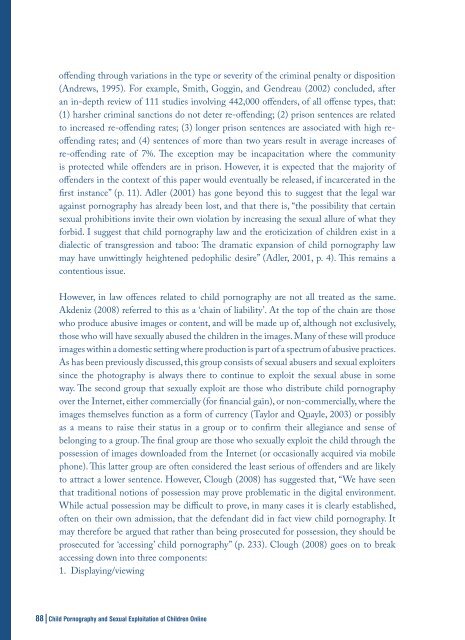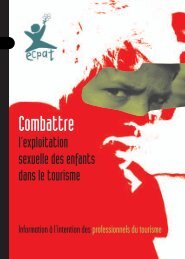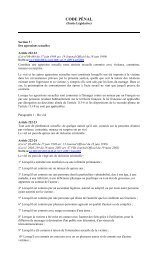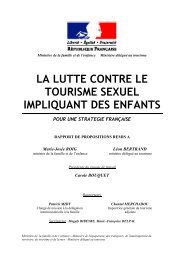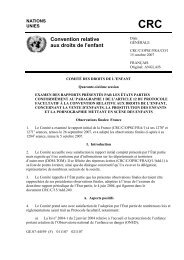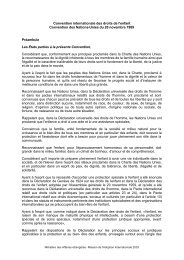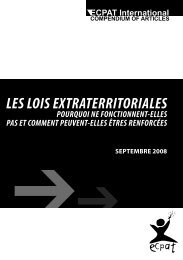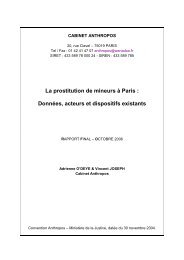child pornography and sexual exploitation of children online
child pornography and sexual exploitation of children online
child pornography and sexual exploitation of children online
You also want an ePaper? Increase the reach of your titles
YUMPU automatically turns print PDFs into web optimized ePapers that Google loves.
<strong>of</strong>fending through variations in the type or severity <strong>of</strong> the criminal penalty or disposition<br />
(Andrews, 1995). For example, Smith, Goggin, <strong>and</strong> Gendreau (2002) concluded, after<br />
an in-depth review <strong>of</strong> 111 studies involving 442,000 <strong>of</strong>fenders, <strong>of</strong> all <strong>of</strong>fense types, that:<br />
(1) harsher criminal sanctions do not deter re-<strong>of</strong>fending; (2) prison sentences are related<br />
to increased re-<strong>of</strong>fending rates; (3) longer prison sentences are associated with high re<strong>of</strong>fending<br />
rates; <strong>and</strong> (4) sentences <strong>of</strong> more than two years result in average increases <strong>of</strong><br />
re-<strong>of</strong>fending rate <strong>of</strong> 7%. The exception may be incapacitation where the community<br />
is protected while <strong>of</strong>fenders are in prison. However, it is expected that the majority <strong>of</strong><br />
<strong>of</strong>fenders in the context <strong>of</strong> this paper would eventually be released, if incarcerated in the<br />
first instance” (p. 11). Adler (2001) has gone beyond this to suggest that the legal war<br />
against <strong>pornography</strong> has already been lost, <strong>and</strong> that there is, “the possibility that certain<br />
<strong>sexual</strong> prohibitions invite their own violation by increasing the <strong>sexual</strong> allure <strong>of</strong> what they<br />
forbid. I suggest that <strong>child</strong> <strong>pornography</strong> law <strong>and</strong> the eroticization <strong>of</strong> <strong>child</strong>ren exist in a<br />
dialectic <strong>of</strong> transgression <strong>and</strong> taboo: The dramatic expansion <strong>of</strong> <strong>child</strong> <strong>pornography</strong> law<br />
may have unwittingly heightened pedophilic desire” (Adler, 2001, p. 4). This remains a<br />
contentious issue.<br />
However, in law <strong>of</strong>fences related to <strong>child</strong> <strong>pornography</strong> are not all treated as the same.<br />
Akdeniz (2008) referred to this as a ‘chain <strong>of</strong> liability’. At the top <strong>of</strong> the chain are those<br />
who produce abusive images or content, <strong>and</strong> will be made up <strong>of</strong>, although not exclusively,<br />
those who will have <strong>sexual</strong>ly abused the <strong>child</strong>ren in the images. Many <strong>of</strong> these will produce<br />
images within a domestic setting where production is part <strong>of</strong> a spectrum <strong>of</strong> abusive practices.<br />
As has been previously discussed, this group consists <strong>of</strong> <strong>sexual</strong> abusers <strong>and</strong> <strong>sexual</strong> exploiters<br />
since the photography is always there to continue to exploit the <strong>sexual</strong> abuse in some<br />
way. The second group that <strong>sexual</strong>ly exploit are those who distribute <strong>child</strong> <strong>pornography</strong><br />
over the Internet, either commercially (for financial gain), or non-commercially, where the<br />
images themselves function as a form <strong>of</strong> currency (Taylor <strong>and</strong> Quayle, 2003) or possibly<br />
as a means to raise their status in a group or to confirm their allegiance <strong>and</strong> sense <strong>of</strong><br />
belonging to a group. The final group are those who <strong>sexual</strong>ly exploit the <strong>child</strong> through the<br />
possession <strong>of</strong> images downloaded from the Internet (or occasionally acquired via mobile<br />
phone). This latter group are <strong>of</strong>ten considered the least serious <strong>of</strong> <strong>of</strong>fenders <strong>and</strong> are likely<br />
to attract a lower sentence. However, Clough (2008) has suggested that, “We have seen<br />
that traditional notions <strong>of</strong> possession may prove problematic in the digital environment.<br />
While actual possession may be difficult to prove, in many cases it is clearly established,<br />
<strong>of</strong>ten on their own admission, that the defendant did in fact view <strong>child</strong> <strong>pornography</strong>. It<br />
may therefore be argued that rather than being prosecuted for possession, they should be<br />
prosecuted for ‘accessing’ <strong>child</strong> <strong>pornography</strong>” (p. 233). Clough (2008) goes on to break<br />
accessing down into three components:<br />
1. Displaying/viewing<br />
88|Child Pornography <strong>and</strong> Sexual Exploitation <strong>of</strong> Children Online


